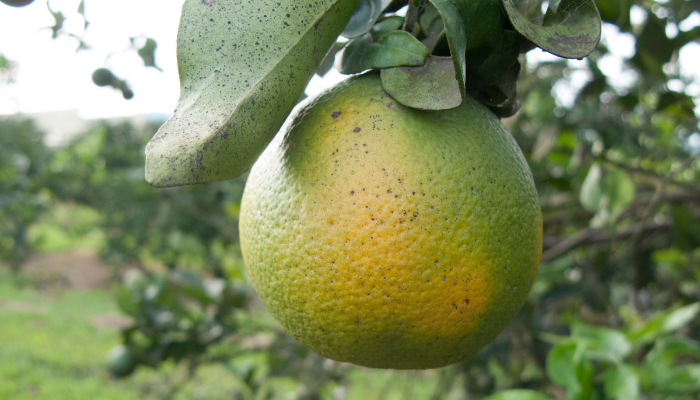Effects of Huanglongbing on Florida oranges

The content of this article 'Effects of Huanglongbing on Florida oranges' was prepared by Tripti Vashisth and others of the University of Florida and has been revised and republished by FreshFruitPortal.com.
This publication offers commercial citrus growers and other stakeholders succinct details about the effects of Huanglongbing (HLB).
It also presents important facts of HLB's history in Florida, illustrated descriptions, and details regarding HLB's effects on fruit yield, appearance, and quality.
Internal fruit appearance
- Symptomatic fruit may have aborted, dark-colored seeds, and the central core may be curved. The juice vesicle color may lighten, moving from the peel to the middle of the fruit.
- Additionally, in past years crystals (believed to be hesperidin) have been observed on the segment membranes, and the albedo may take on a bluish tinge (such observation is not common at present)
External fruit appearance
- Symptomatic fruit appear lopsided (A), often oblong (B), with a tendency to be smaller than normal (C), and frequently with an inverted color change (green shoulders, orange blossom end). Additionally, fruit often have a yellow stain below the calyx (point of stem attachment, D) when compared to healthy fruit (E).
Fruit size and yield
- HLB-affected trees have a significantly greater portion of fruit in smaller size categories compared to healthy trees—over 95% of symptomatic fruit are < 2.25" in diameter.
- Most HLB-symptomatic fruit could be eliminated by removing fruit that is < 2.25" in diameter.
- Total juice volume produced will be less from HLB-positive trees due to smaller fruit size.
- HLB-affected trees appear to have good yields at least one year after known infection.
- Yield does not appear to be consistently reduced until > 25% of tree canopy is symptomatic.
- Treatments to improve tree health may not improve fruit size, but appear to slow within tree disease spread and maintain total yield.
Fruit quality
- The ratio of sugars to acid (Brix/acid ratio) is used as a maturity and quality indicator. Three types of fruit were compared:
- Control fruit that was harvested from a non-infected tree
- Asymptomatic fruit that did not show physical symptoms of HLB, but came from an HLB-affected tree
- Symptomatic fruit that did show physical symptoms of HLB and came from an HLB-affected tree
- Brix/acid ratios were as much as 13%–24% lower and acid levels were as much as 18% higher in symptomatic juices compared to control.
- Juice from symptomatic fruit was less sweet and more tart/sour than that from control fruit. Symptomatic juice appears to be from less mature fruit, even though the juices are from fruit of the same age.
- Potential immature flavors in HLB fruit make removal desirable.
- Only symptomatic fruit from HLB-affected trees show quality changes (rendering it similar to immature fruit).
Huanglongbing history
- Huanglongbing is a plant disease caused by Candidatus Liberibacter asiaticus, a phloem-limited bacterium affecting all citrus cultivars.
- In 1995, the official name for citrus greening became Huanglongbing (HLB).
- The vector, Asian citrus psyllid, was first found in Florida in 1998.
- HLB was first detected in south Florida in August 2005.
- As of October 2006, HLB-affected trees had been found in twelve counties.
- Thirty-two counties had confirmed HLB in their area by the end of 2008.
- By February 2010, thirty-four counties (dark blue on map), including all commercial citrus producing counties, were confirmed positive with at least one HLB-affected tree.
- Symptoms can be found year-round, but are more prominent September through March.
Contacts: Tripti Vashisth, Horticultural Sciences 863-956-8846; Yu Wang, Food Science and Human Nutrition 863-956-8673; Michelle Danyluk, Food Science and Human Nutrition 863-956-8654; Renée M. Goodrich-Schneider, Food Science and Human Nutrition 352-392-1991 ext. 208; Charlie Sims, Food Science and Human Nutrition 352-392-1991 ext. 211.




































